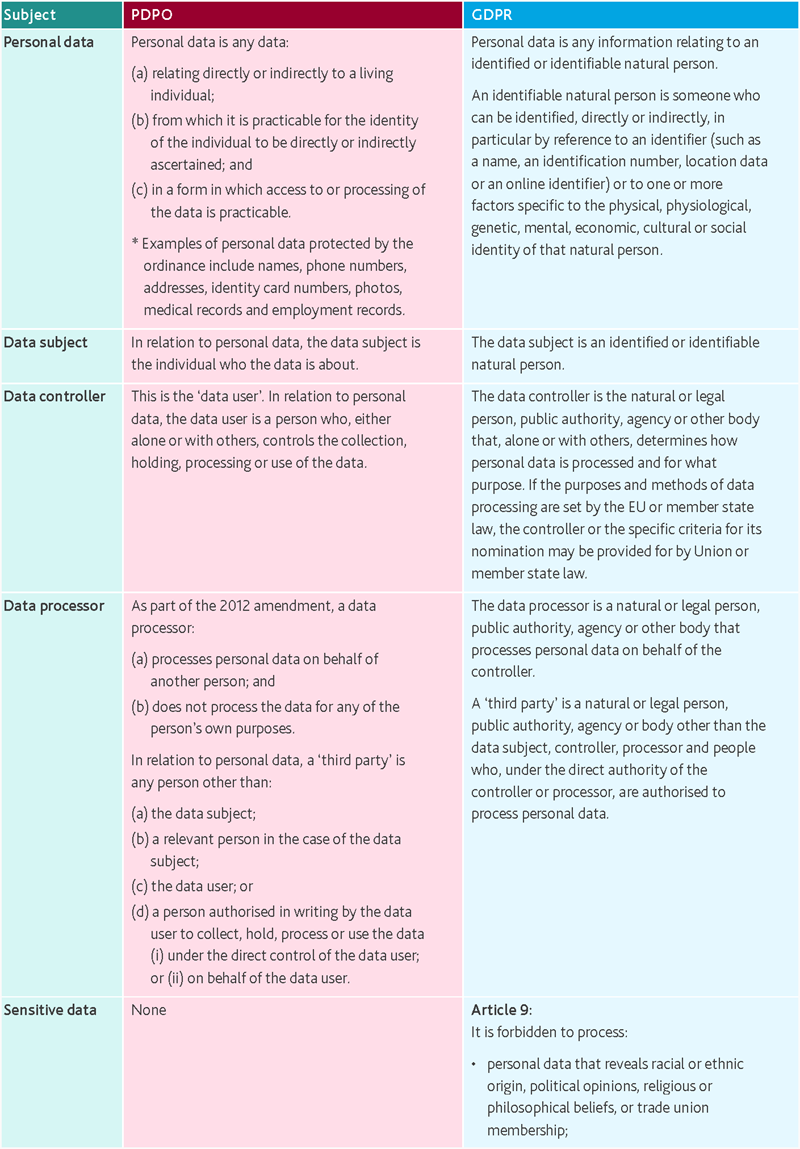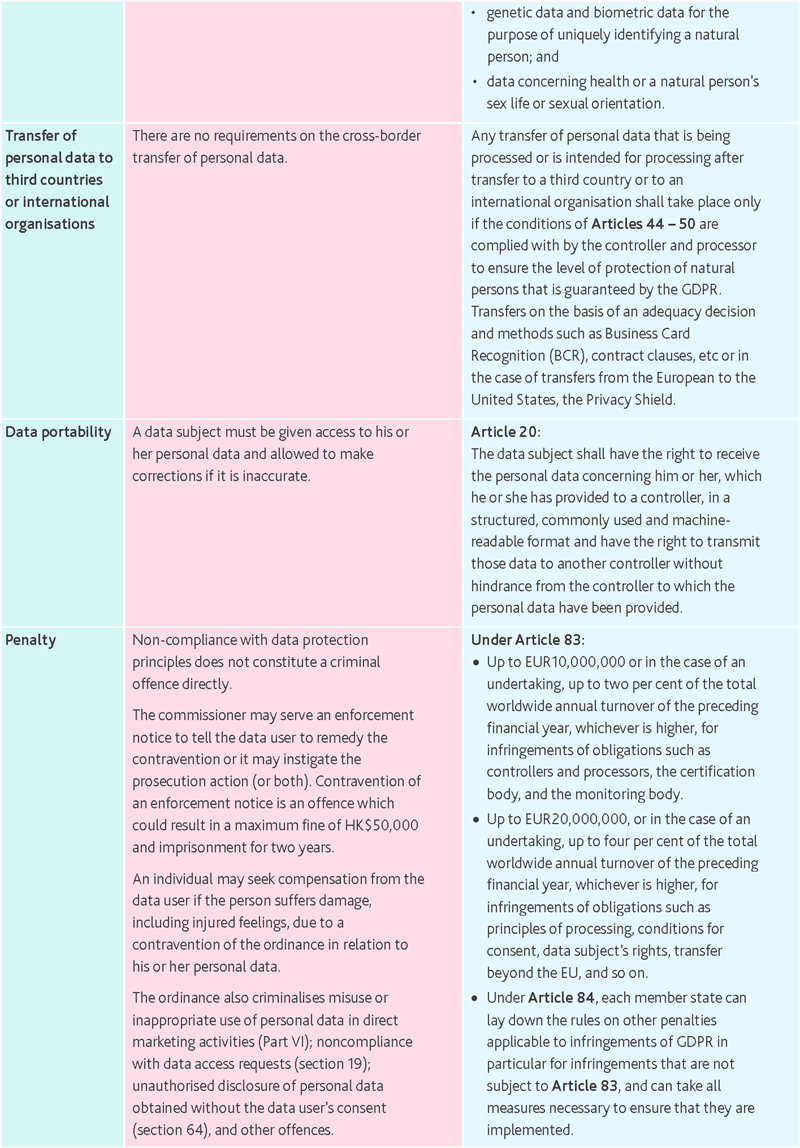Following a lengthy adoption process that began in April 2016, the EU General Data Protection Regulation (GDPR) will take effect from 25 May 2018 throughout the countries of the European Union. The GDPR will replace existing data-protection laws throughout the EU, but it will have a significant impact on businesses around the world, regardless of where they operate. Time is running out: if Hong Kong businesses have not yet addressed the GDPR requirements, they should immediately assess how the GDPR will impact their business and update their data-protection policies and practices to comply with the requirements.
The GDPR aims to strengthen the laws on the protection of 'privacy data' that relates to an identified or identifiable 'natural person' (ie, one who has its own legal personality). Privacy data includes the following:
- basic information about a person's identity, such as their name, address and ID number;
- web data, such as location, IP address, cookie data and radio-frequency identification tags;
- health and genetic data;
- biometric data;
- racial or ethnic data;
- data about their political opinions; and
- data about their sexual orientation.
Any organisation that stores or processes personal information about EU citizens in EU states must comply with the GDPR, even if they do not have a business presence in the EU. An organisation must comply with the GDPR requirements if it:
- has a presence in an EU country;
- does not have a presence in an EU country but offers goods or services to individuals in the EU or monitors an identifiable natural person (data subject)'s behaviour in the EU (monitoring behaviour could include using cookies to track online activity and develop user profiles, even without knowing the users' names);
- has more than 250 employees; or
- has fewer than 250 employees but processes their personal information in a way that would affect the rights of data subjects repetitively.
To enforce the requirements of the GDPR, the European Parliament is introducing the following significant changes:
- GDPR defines three roles that are responsible for ensuring compliance: the data controller, the data processor* (see the note below) and the data protection officer (DPO). The data controller defines how personal data is processed and the purposes for which it is processed. The data controller is responsible for making sure that external contractors comply with the regulation. The GDPR requires organisations to appoint a DPO, and the data controller and data processor must assign the DPO to overseeing the organisation's data security strategy and GDPR compliance.
- The conditions for requesting permission to use personal data have been made stricter. Organisations must obtain permission separately from other permissions and ask for it in a way that is easy to access and understand, using clear and plain language. The consent for requesting the withdrawal of the use of personal data should also be the same as the request for consent to use it.
- The rights of data subjects have been strengthened and new rights have been introduced. These include the following:
‐ the right to transfer their data to another processor (known as 'data portability');
‐ the right to require the data controller to erase their personal data, to require them to
stop sharing it with others, and, potentially, to have third parties stop processing the
data (known as 'data forgotten'); and
‐ the right to obtain confirmation from the data controller about whether or not their
personal data is being processed, where it is being processed and for what purpose it is
being processed (known as 'data access').
- Organisations must notify the regulatory authorities and the individuals concerned about any data breaches (eg, accidental or unlawful loss of, theft of, access to or disclosure of personal data) within 72 hours of noticing the breach.
- Data processors (ie, organisations that process personal data on behalf of other organisations) are now directly and legally responsible for complying with several obligations set out in the GDPR, including ensuring that the data is protected at the technical and organisational level.
- The GDPR does not require all personal data to be kept within the EU. However, if personal data is transferred outside the EU, data controllers should ensure that there is a similar level of technical and legal protection for the data. Therefore, the GDPR implements 'privacy by design', which calls for data controllers to protect personal data and consider the amount of personal data collected, how long it is kept for and how it can be accessed.
- For the most serious offences, the maximum fine that can be imposed for breaking the conditions of the GDPR is €20 million or four per cent of an organisation's worldwide turnover, whichever is highest.
In anticipation of the changes in the data-protection laws in EU countries, we have looked at the Personal Data (Privacy) Ordinance (Cap 486) (PDPO). The PDPO came into force in Hong Kong on 20 December 1996, just one year after the European Data Protection Directive of 1995, and certain aspects of the PDPO were developed based on the directive. The PDPO set out principles that data users must follow when handling personal data about individuals. The PDPO and the GDPR cover some of the same subjects. Their definitions of these subjects are set out below:


Source: The Privacy Commissioner for Personal Data, Hong Kong
Members of senior management team should undertake a holistic review of whether their organisations are ready for GDPR compliance. Your organisation may consider taking the following steps to prepare:
- Conduct an information audit to map data flows and document what personal data you hold, where it came from, who you share it with and what you do with it. Address the risks of cross-border transfer of personal data, especially in virtual and cloud environments, where cross-border data replication and movement is common.
- Designate a team of key members of the senior management team, IT and various operational and support departments to develop a plan for GDPR compliance and educate others about its impact on operations.
- Appoint a Data Protection Officer to implement and monitor your GDPR compliance plan. This person should act as the head of your data protection governance structure and report directly to the senior management. If your business operates outside the EU, you will need to appoint a representative within the EU in writing.
- Ensure an appropriate data-protection policy is in place and review the basis for collecting, processing and maintaining personal data, especially the rights to access, accuracy, quality, retention and disposal of personal data.
- Implement a new compliance system with built-in technical and organisational measures for integrating data-protection functions into all processing activities from your end points.
- Review your contracts with third parties and customers with whom personal data is shared and, where necessary, renegotiate terms of business to ensure appropriate supervision over the processing of personal data and compliance with the GDPR.
To minimise the risk to your business operations after the regulation takes effect on 25 May 2018, you should act immediately to address the requirements of the GDPR.
*Note: Data processors may be internal employees or an internal department that maintains and processes records of personal data, or any outsourcing vendor that performs all or some of those activities. The GDPR holds data controllers and data processors legally responsible for breaches or non-compliance. Therefore, both the organisation and a processing partner (such as a cloud provider) may be liable for penalties, even if the fault is entirely that of the processing partner.
To download the complete flyer, please click the below button.